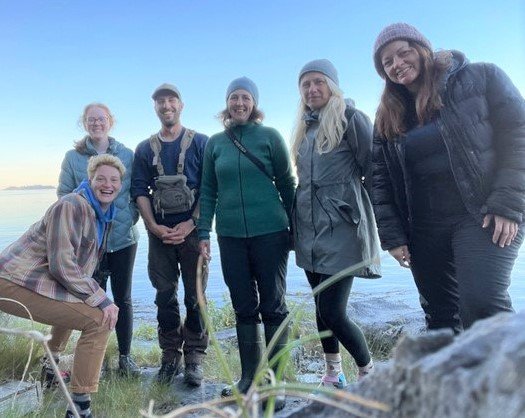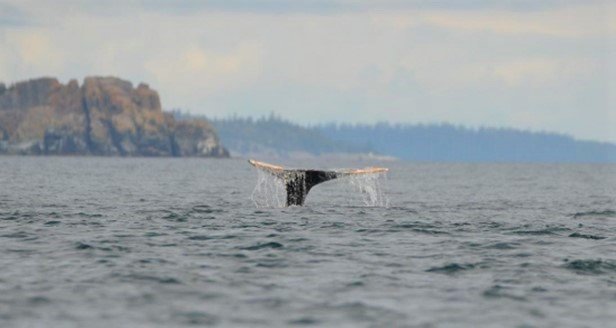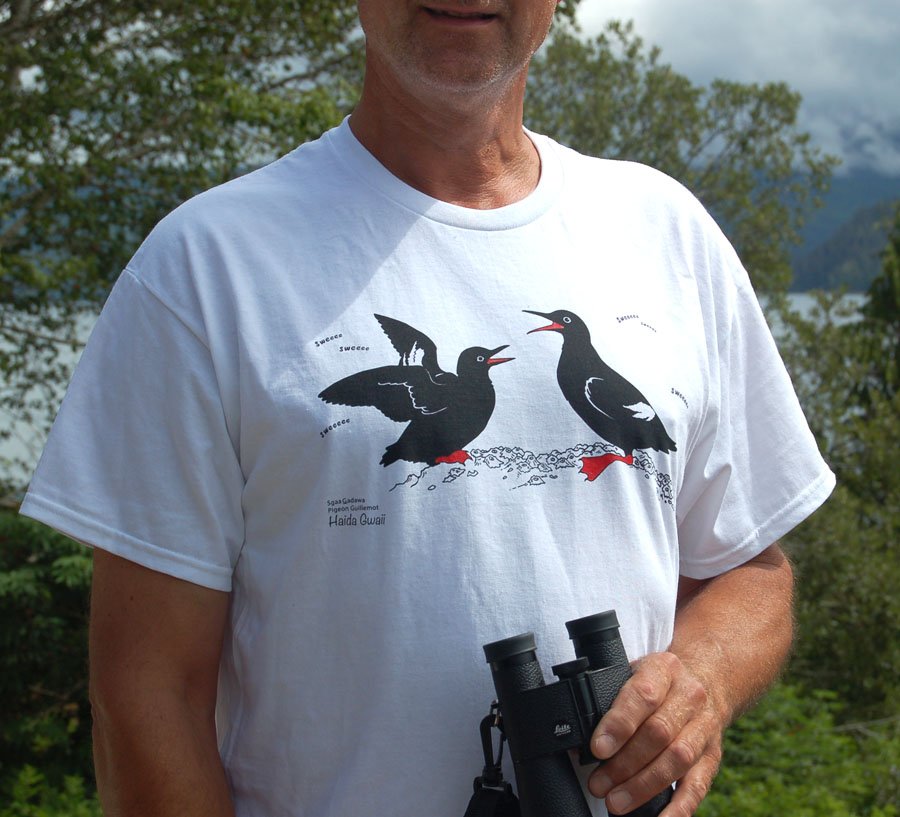Fifth and final Limestone Log of 2022, as we wrap up another successful field season!
Welcome to our fifth and final Limestone Log of the 2022 Field Season!
Crew for week 11 - Lindsay Curle (Media Intern), Megan Scott (Student Intern from SFU), Jesse Beaubier-Brulotte (LBCS Research Assistant), Rian Dickson (LBCS Biologist), Lisa Krahn (volunteer), and Julie Valet (volunteer). Photo credit: Lindsay Curle
Black Oystercatcher Surveys - Part Two
Week 9 on Limestone Island saw the return of Jake Pattison and Lindsay Curle, as well as some new arrivals. Jesse Kemp and Hannah Roodenrijs are two Masters students from Simon Fraser University, working to band Black Oystercatchers in Laskeek Bay and Skidegate Inlet. This time around there were plenty of eggs, as well as nearly twenty healthy chicks!
The banding initiative was also a success! One very special bird was captured on Gooden Island (aka Party or Picnic Island), right in front of Daajing Giids (formerly Queen Charlotte) in Skidegate Inlet, with a band number 785-35704. The number indicates that this oystercatcher was banded by Anthony Gaston, founder and scientific advisor for Laskeek Bay Conservation Society, on the 23rd of June 1995 at Limestone Island when it was just a chick. This means that the bird is 27 years old, which is the oldest Black Oystercatcher currently on record! Despite its impressive age, the bird is still healthy and reproducing, as it was observed with a large chick. This is an incredible find, and a reminder that there is still so much to learn, even about the birds that we can see around town every day!
If you do observe a banded oystercatcher please contact us or Hannah Roodenrijs (hannah_roodenrijs@sfu.ca), with the time, date, location and band number/letter. If you can get a photo, that’s a great way to confirm the sighting!
Please remember, if you are observing birds or other wildlife, keep a respectful distance and use binoculars, a spotting scope, or a camera with a telephoto lens to get a closer look.
Close-up photo of a banded Black Oystercatcher - the letter/number combination on the green band is unique for each individual.
Photo credit: Hannah Roodenrijs
A banded Back Oystercatcher – the green alphanumerical bands are visible above the joint, as well as a metal band on the right leg.
Photo credit: Hannah Roodenrijs
Trail Maintenance
After a couple months of fieldwork on East Limestone Island, some of our trails needed attention. Thankfully, Barrett Johnson was able to split some beautiful cedar planks to be used for constructing new steps, as well as 200 new stakes to mark the various trails on the island. The moss on Limestone quickly swallows anything set on the ground, and many of the markers have been lost to the forest so we are very grateful for all the hard work done to keep our trails safe and clearly marked.
Trail junctions are marked by signs featuring some of the wildlife seen in and around Laskeek Bay
Bald Eagle pair perched in a snag near their nest
Photo credit: Julie Valet
Wildlife Trees
Despite most of the residents having fledged and moved on, there was still work to do involving wildlife trees. Two trees were still occupied, including a Bald Eagle nest with a chick and an active cavity nest housing a family of Tree Swallows. Staff and volunteers have been watching the Bald Eagles all season, but unfortunately did not get to see the chick’s first flight. The last few observations included one parent catching a rockfish and bringing it to the chick, and an unusual sighting where each adult carried a stick to the nest – perhaps the nest required some end-of-season maintenance as well! Many of the wildlife trees needed to be measured and tagged, a task that demanded some extensive bushwhacking by Jesse Beaubier-Brulotte and Megan Scott.
Mystery Solved!
For those of you who have been waiting to hear the news - we have confirmation that our rein-orchid is indeed Platanthera ephemerantha (white-lip rein orchid or white flower rein orchid)! This species is blue-listed in British Columbia, meaning that is of special concern, and while it is found from Alaska to Californian, it is rare in coastal BC. It has been previously reported from Haida Gwaii, near the headwaters of the Honna River, but otherwise it is mainly found on southern Vancouver Island.
At last - close-up view of the White-lip rein orchid in bloom!
Photo credit: Rian Dickson
Sea Survey
Now that the 2022 field season has come to a close, we have been taking a trip down memory lane to share all of the highlights of our sea surveys with you. This year, we completed 5 separate surveys of our Laskeek Bay transect route, with approximately one survey every two weeks. We were pleased to observe over 200 Ancient Murrelets during two separate sea surveys, once on May 19 and again on May 30.
There was no shortage of marine mammal sightings either! On July 16, the survey crew almost overlooked what appeared to be a floating log between Low and Reef islands. Luckily, they did a double take to discover it was actually a Northern Elephant Seal! These elusive marine mammals spend the majority of their life underwater, but we managed to catch sight of one during the few minutes that it came up for air.
A Northern Elephant Seal, looking very much like a ‘deadhead’ (i.e., a partially submerged log floating vertically in the water). Shortly after we spotted it, it disappeared beneath the surface.
Photo credit: Jesse Beaubier-Brulotte
Humpback whale showing its tail flukes before a longer dive.
Photo credit: Andrew Jacobs
On June 13, a variety of marine mammals graced us with their presence as well. Two groups of humpback whales were spotted east of Low Island. One group of five included a mother and calf, and the other group had three individuals. At the end of the day when the survey was nearly complete, a single male killer whale surfaced on the west side of Low Island as well. It was a happening place for whales that day!
Male Orca surfacing on a glassy calm evening. This Orca has a very distinctive scar on its dorsal fin, which causes the top of the fin to appear to be curving forwards. In this photo, he is actually swimming from right to left, but kind of looks like he is going the opposite way!
Photo credit: Andrew Jacobs
Further Out In Laskeek Bay...
Finally, on June 25, a bait ball of fish was detected about 2 km out from Cumshewa Island. We spotted this event due to the vast number of wildlife feeding on it in the ocean. Among these were a Minke Whale, 700 Rhinoceros Auklets, and 70 Bald Eagles!
Tufted Puffin observed near Reef Island in Laskeek Bay as the crew headed out for a day of Black Oystercatcher surveys.
Photo credit: Jake Pattison
Camp Shutdown
The end of the field season is always bittersweet, but there wasn’t much time to reminisce during week 11. Camp shutdown was in full swing, with the Lookout Point blind and Pigeon Guillemot camera boxes needing to be disassembled, as well as general packing around camp. Solar panels, batteries and other heavy loads needed to be hauled, and we are thankful to have had the help of volunteers Julie Valet and Lisa Krahn for this last week on Limestone.
Here we see Jesse, Rian and Megan heading up to Lookout Point to begin taking down the blind. Photo credit: Lindsay Curle
A Day in Laskeek Bay – 5 July 2022
A drizzly morning in the mist,
We boated across to Limestone West.
We set up some lines and placed the decoy,
And caught ourselves a pair of BLOY.
Hoping the sea didn’t soak our socks,
We took some prey samples from the rocks.
Limpets, Chitons, Snails and Mussels,
But Clam remained an unsolved puzzle.
We then said hello to Island Solitude,
And they shared with us a bit of food.
The air now dry, across to South Skedans,
Trapping two chicks and two adults went as planned.
More prey samples taken in the sun,
Meanwhile BLOY surveys on Kingsway were good and done.
On Skedans we set some raccoon cams,
But we never did find a clam!
by Jesse Kemp
Abalone Shell, by Megan Scott
Thank you!
Haawa/Haw'aa to all our volunteers and student interns (Lindsay Curle, Andrew Jacobs and Megan Scott), our field staff (Jesse Beaubier-Brulotte, Matthew Peck, Jake Pattison, Ainsley Brown), Hannah Roodenrijs and Jesse Kemp from SFU, our neighbours at K'uuna for their hospitality and generosity, Moresby Explorers for logistical assistance and delivery of treats from K'uuna, and Bluewater Adventures for bringing their guests to the island to learn about the work being done. In the Haida language there are no goodbyes, only see you again, and we hope to see you again very soon for our next field season.
.
"Tricky Trivia"
Answer to the previous trivia question:
Our last trivia question asked which of these mammal species, Sitka black-tailed deer, Raccoon, River Otter, Roosevelt Elk, Beaver, Black Rat, Muskrat, and Red Squirrels, is native to Haida Gwaii?
For those of you who answered River Otter, congratulations you are correct! All the other species on the list have been introduced by humans.
Squirrels were originally introduced to Haida Gwaii in 1950, to make it easier for forestry crews to collect spruce cones for silviculture. In addition to spruce seeds and other vegetation, squirrels are known to also feed on songbird eggs. Squirrel surveys are conducted on East Limestone Island throughout the field season to monitor their abundance. Sitka black-tailed deer browsing has drastically changed the environment on many of the islands, including East Limestone where deer exclosures have been installed to study what natural vegetation growth would look like in the absence of deer. Trail cameras are also deployed to monitor deer and any possible raccoon sightings in the area.
Our newest Pigeon Guillemot t-shirt is selling fast! Please visit our website in the next few weeks if you would like to purchase online, $30, various sizes left.
The design is by local artist and Laskeek Executive Director, Judy Hilgemann.
Follow us on facebook for more Limestone Adventures!
Our user name is Eli Laskeek Seabird.
The Laskeek team would like to send out a big HAAWA & THANK YOU to our sponsors and supporters who have made our 2022 projects possible: Gwaii Trust, the Council of the Haida Nation, B.C. Gaming, Gwaii Haanas, B.C. Parks, Northern Savings Credit Union, the Habitat Stewardship Program, Bluewater Adventure Tours, and the Canadian Wildlife Service.
We are happy to report that the Laskeek Bay Conservation Society is now wrapping up a successful season of volunteers, tour groups, and community events planned. Stay tuned for a Field Season Summary, coming to our website very soon. If you missed your chance to join us as a volunteer on East Limestone Island, please consider applying for the 2023 season. We will begin taking volunteer registration early in 2023 - watch our website for updates in January.
You may have noticed the change of name for the community formerly known as "Queen Charlotte". The Laskeek Bay Conservation Society proudly supports the restoration of the original Haida name of "Daajing Giids" to our vibrant community.
Donations to support our ongoing programs remain crucial to our continued success - please click on the Donate Now button below, to be taken to our website donation page.














